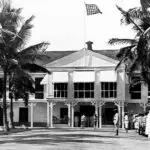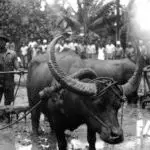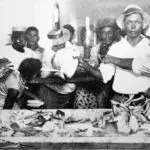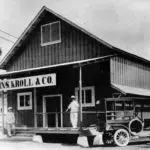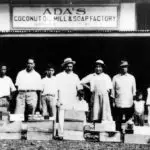Early American Economic History
Table of Contents
Share This
Editor’s note: This entry was adapted and reprinted with permission from Kinalamten Pulitikåt: Siñenten I Chamorro (Issues in Guam’s Political Development: The Chamorro Perspective). The Hale’-ta Series. Hagåtña: Political Status Education Coordinating Commission, 1996.
Influenced by Navy's needs
When the US established a military government in Guam in 1899 it became clear that the costs of administering Guam would be high. The US military government renewed the efforts started by the Spanish government to establish an agricultural economy on the island. Simultaneously, many different methods were used to persuade the CHamorus to adapt to the American way of doing things.
Capt. Richard P. Leary, Guam’s first Naval Governor, made several administrative decisions that served as legal precedent. Among the most important were the prohibition of land sales without the prior approval of the Naval government and the closing of Guam to outsiders who did not first obtain a permit from the US Navy.
While Governor Leary may have intended to protect the property rights of the CHamorus from the colonial activities of other nations in the region (particularly the Japanese) the restrictions applied equally to land sales to other CHamorus and to US citizens. By restricting outside investment in the island these rules inhibited the economic development of Guam for many years.
The US also followed the Spanish precedent by importing labor into Guam. While the reason for this is not well documented, it kept wage rates low so that the Navy would have the access to an inexpensive source of labor on an as-needed basis. In general, the top jobs in the Naval Government of Guam were assigned to Naval officers. Most of the civilian jobs in the military were given to imported labor from the states and from the Philippines. While some positions in the Naval government were assigned to CHamorus, most CHamorus were encouraged to engage in agricultural production because the Navy wanted to minimize the costs of its occupation of Guam.
Since much of the CHamoru ancient clan system had survived through the Spanish colonial period, and because CHamorus had never had much use for money, the Naval government found it difficult to convince people to produce more than they needed for themselves.
Overall, the colonists’ assessment of Guam’s economy was based upon their own standards rather than upon a more realistic model derived from the perceptions and preferences of the CHamoru people. Consequently, a dual economic system operated in Guam. Part of the system was based upon monetary exchange (much as we have today) for the colonists and the few CHamoru wage earners; the other was based upon subsistence production at the lancho (family ranch) and bartering for the rest of the CHamoru population. For this reason, there was very little production to meet one of the Navy’s major reasons for holding Guam: providing fresh food and water for the US Pacific Fleet.
Gradually, though, the CHamorus began to want the new and different products that were available to military and government wage earners, and they began to accumulate the money necessary to buy things for themselves and their families.
Between 1899 and 1941, there was a gradual growth in economic activity in Guam, spurred mainly by the basic economics of colonialism. Any development that was encouraged (or even allowed) was designed to provision ships calling at Apra Harbor and to minimize the costs to the US government of administering the colony. Economic activity was based largely on agricultural production, small-scale retailing and trade in copra, the dried meat of coconuts, from which coconut oil is extracted. At that time, coconut oil had many commercial and industrial uses.
A public market was established near the Paseo de Susana, where farmers could sell their fruits and vegetables, and fishermen could sell their catch.
In 1914, the Navy invited Atkins Kroll (AK) to operate a trading company in Hagåtña. In 1917, the company bought a coconut plantation at Tarague in northern Guam. AK’s operations gradually spread throughout Micronesia, with copra from the other islands being consolidated and shipped out of Guam in 100-pound sacks, creating what has been called a “copra economy.” Both before and after World War II, the Naval government often measured land values, for property tax and other purposes, according to how many coconuts the land could produce.
The Naval government opened a Bank of Guam in 1916, the first bank in the history of Guam. Although the first Bank of Guam was principally established as a convenience to the Navy and its personnel, local merchants quickly learned to take advantage of its services in transferring money to their suppliers in Asia and the US, borrowing money to meet business needs, and protecting their money in its safe. The bank made a profit from its loans and the services it provided, and returned a part of this profit to its depositors in its first year of operation.
During the US Naval Era, a number of other privately owned businesses formed in Guam, many of which prospered. Many, though, were operated by immigrants who were allowed by the Navy to remain in Guam for various reasons.
One outstanding exception was the Ada Soap Factory which manufactured a type of lye soap called “saltwater soap” because it worked well in saltwater. It was made from coconut oil and ashes. Ada’s soap was of the highest quality available. It is reported that at one point Ada supplied the saltwater soap needs of the US Navy Pacific Fleet.
Throughout the period basic sanitation facilities, utilities and other public services were modernized in Guam. There was a public power plant built in Hagåtña to supply power to Naval government offices; water wells were drilled and water systems were installed; a hospital was built and staffed for the CHamoru population. Crushed coral was laid for the main roads.
The Naval government was concerned about public health and as a result, the general health of the people of Guam improved. This too is a step forward in economic development.
Disaster factor
One of the major obstacles to development in the US Naval Era of Guam’s history had nothing to do with colonization, or any other device of man. As always before and ever since, Guam was repeatedly assaulted by natural disasters. Earthquakes and typhoons destroyed houses and other structures, wasting the thousands of man hours it took to build them. Typhoons and droughts ruined crops, leaving people without enough to eat. In one 48-hour period in 1924, thirty-three inches of rain fell and destroyed crops and buildings all over the island. This deluge even changed the course of some rivers.
The frequency of natural disasters in Guam has influenced every aspect of CHamoru life. It has affected the lifestyles of the people and limited their choice of how to organize economic habits and relationships. It continues to affect everyone’s life today – from the types of buildings that we build and the cost of those buildings, to the prices we pay for food and other items and the types of things that we buy.
Security clearance
Although the Naval government had the authority to allow or deny entry to anyone coming into Guam, in 1941 President Franklin D. Roosevelt expanded and reinforced this authority with a presidential executive order. This was done to maintain the military security of the island in light of Japan’s increasing military presence and strength in the Pacific.
With World War II in the offing in 1941, the security clearance requirement was a reasonable decision. However, its continued application after the war, supposedly to protect the native population from harmful outside influences, caused many problems for the economy and the people of Guam. The effects of the security clearance requirement haunted the Guam economy for the next 25 years.
American reoccupation
The American re-invasion of Guam in 1944 caused more damage than any earthquake, typhoon or other event in history. The economy was totally destroyed, but this time even the land was ruined for farming. The CHamorus were relocated from the Japanese concentration camps into US refugee camps, where conditions were a little better. In the following weeks and months, food and building materials became more available for civilians. In the meantime, the military started a build up of Guam as the main forward base for the direct attacks on Japan. This effort required the occupation of large amounts of land area. The CHamorus, most of whom had no homes to return to, were again relocated away from their properties, but were reasonably well cared for during the remainder of the war.
August 1944 marked the beginning of the military land-takings. At one point, as much as 82 percent of the land in Guam was under military control for military purposes. These areas were off-limits to all but authorized personnel. Anyone caught entering without authorization could be shot on sight. Numerous military bases were quickly constructed by 18 engineering and construction battalions, and the Army began flying daily bombing missions over Japan in B-29 bombers based at what is now Andersen Air Force Base.
What had been a defenseless Navy coaling station just three years before soon became a bastion of American military might with numerous bases, ships, plans and more than 205,000 soldiers during this period.
Post-war recovery
The CHamorus were moved from the refugee camps and into resettlement sites with generous distributions of rations. These sites became the new villages of Agana Heights, Hågat, Sånta Rita-Sumai, Talo’fo’fo, Yona, Sinajana, Barrigada and Dededo. None of these areas had been major population centers before the war. The establishment of new villages dramatically changed the distribution of the island’s population.
For several months following the US occupation, Guam was under martial law. Travel was restricted, curfews were set, and food was rationed. The process of education, which had been important to the pre-war Navy government as the means to develop and train a skilled workforce and as a method of controlling the population, resumed as early as October 1944. Temporary repairs were made to the island’s least damaged schools, while in other areas military tents and canvas roofed structures of wood and tin were made to serve as temporary classrooms. The re-opening of schools kept teachers, children and parents quite busy.
In addition to schools, civilian businesses began to reopen in October 1944. To reduce the burden on the military of operating a rationing program for food and other items, several pre-war store owners were offered places to rebuild their stores and inventories to stock the shelves. At first, the goods and merchandise were drawn from military supplies. The rationing of goods ended not long afterward. With money earned from their new jobs, many people were able to buy things they had never seen or could not afford before the war.
Farming was not possible for a time because of the widespread devastation and the loss of the island’s best farmlands to the new military bases. Without access to their lancho, CHamorus were forced to seek other ways to make a living. This was the beginning of their economy’s rapid transformation from subsistence agriculture and bartering to a system of wage employment and monetary exchange. In the course, several stages in the normal process of economic evolution were skipped. The transformation of the traditional CHamoru economy was the final step toward the Americanization of the economy of Guam.
Between 1945 and 1950, during the construction of the bases and the reconstruction of civilian communities, there were so many jobs to be done that the Navy began importing labor from the Philippines. With jobs in military construction and in the military government readily available, employment among CHamorus was extremely high also. The economy was transformed almost overnight into a service-oriented system.
In this new wage and money economy, new private businesses sprang up like never before. In January 1946, the Bank of Guam reopened. It quickly grew and gave new businesses access to credit and an easy method of transferring funds to their off-island suppliers. For many years, Guam experienced an economic “boom” a period when the economy grows more rapidly than it normally would, even in good years. Incomes and the island’s standard of living rose rapidly.
The main roadway in Guam, Marine Drive (now called Marine Corps Drive), was constructed early in the post-war years to provide for rapid transportation among the military bases. New water and power systems were designed and built exclusively to meet the needs of the occupying US forces. Later, as military needs subsided, there was so much excess capacity that there was no justification for denying their use by the civilian community.
Thus, civilian businesses and households were finally able to tap into these “modern” conveniences. Because of the constant flow of traffic on Marine Drive, and because the utility lines also ran alongside it, civilian homes and businesses began to sprout up along its length. Marine Drive, its accompanying utility lines, and the port at Apra Harbor are perhaps the three most important things that sets Guam apart from other islands in the western Pacific to this day. The use by civilians of facilities originally intended by the colonizers for themselves has almost accidentally allowed Guam’s economy to develop to the degree that we have today.
The Bank of Guam, formerly a Navy-owned establishment, was sold in 1950 to the Bank of America (of California). The Navy News, a daily newspaper published by the military, was sold to Joe Flores, and became the Guam Daily News, also a civilian business operation.
With effective recovery of the island’s civilian community, the next step along the road to economic progress required a degree of local political control and local self-government. The signing of the Organic Act by President Harry S. Truman on 1 August 1950 removed Guam from being under the US Navy, and allowed the people to have a civilian government provided that impetus.
For further reading
Farrell, Don A. The Pictorial History of Guam: The Americanization 1898-1918. 2nd ed. Tamuning: Micronesian Productions, 1986.
Hattori, Anne Perez. Colonial Dis-ease: U.S. Navy Health Policies and the Chamorros of Guam, 1898-1941. Pacific Islands Monograph Series 19. Honolulu: University of Hawai’i Press, 2004.
Hinasso’; Tinige’ Put Chamorro (Insights: The Chamorro Perspective). The Hale’-ta Series. Hagåtña: Political Status Education Coordination Commission, 1993.
Rogers, Robert. Destiny’s Landfall: A History of Guam. Honolulu: University of Hawai’i Press, 1995.

